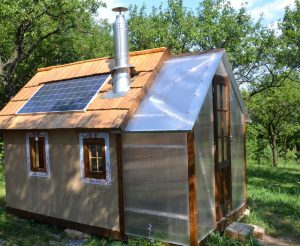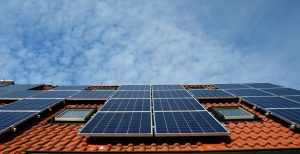Thankfully there is now much more emphasis on environmentally positive design and this whole area is constantly evolving. Of course it isn’t just design, but manufacturing, construction, distribution, systems… everything that we do, make and use.
There’s no substitute for the “reduce, re-use, recycle” mantra that is in common use, the most important part is the first – REDUCE. Our use of energy and resources and the demand to consume more can’t continue, so a reduction in our use – of everything – is essential.
That gives design, environmentally sensitive design, a truly world changing role. There are some interesting areas of development and some where the work is only just beginning:
 Tiny houses
Tiny houses
There’s a big movement towards Tiny Houses at the moment. These trailer or container sized homes can provide an effective housing solution where land and/or money is short. Of course, being relatively tiny they are much more able to be fully resourced by integrated renewable energy, water recovery and composting toilet systems. There are some downsides too – apart from the lack of space; having a larger surface are to volume ratio than conventional properties means that they could be more vulnerable to heat loss or heat gain unless that’s addressed by integral shading or insulation. Maybe the next step should be to develop earth-sheltered tiny homes? Being small, the usual problems of living underground (access to natural light and escape in the event of fire) could be more easily mitigated. Maybe the next big thing could be Burrow Living…?
 Composting Toilets
Composting Toilets
Surprisingly the flush toilet has been around since the Bronze Age in various ways. Following significant improvements in technology during the Industrial Revolution it has become a very effective waste disposal system that unfortunately uses one of our most precious resources – water; so the water flushed toilet has become the norm. Composting toilets address this by, as the name suggests, turning human waste into usable compost without additional water. These toilets are currently mainly used for off-grid applications and do need careful management to address the problems that arise from pathogens and contaminants in the waste. There would also be a lot of scalability and infrastructure problems to be addressed if everyone were to install a composting toilet…
There’s a huge design challenge here; design a universally usable human waste disposal system that is as user friendly as the flush toilet – but without water. Answers please – soon…
 Distributed Generation
Distributed Generation
It simply very logical that power should be generated near to where it’s consumed. As renewable energy from solar, wind and geothermal sources become technically more cost effective it’s also becoming easier for that energy to be stored and used at source.
What we do need to be careful of as designers is the total energy cost of doing this. We have to ask ourselves what is the real energy and environmental cost of producing the turbines, generators and batteries, getting them to site, or building them into a product, maintaining them and disposing of them as compared to a more centralised system?
Providing that equation is positive then distributed generation makes sense – only let’s not make any untested assumptions about the true environmental cost.
 Distributed Manufacturing
Distributed Manufacturing
Another “Distributed” topic! This is going to be big…
What if, instead of your washing machine being made in Germany, or China and shipped around the world, it was made in your town, or your village?
It could be any product that we need or use, and it’s a great challenge to product designers. We need to reduce the environmental and energy footprint of products, could making them locally do that? As with power generation the energy balance would have to stack up. It means looking at products in an entirely different way and considering not just what they do, but why they do it.
What is the purpose of a washing machine working in the way it has always done or looking the way it always has? How do we persuade or enable people to wash their clothes less so that the machines can be simpler? It’s a huge area for development and has already started in a small way with small spare parts being manufactured locally by 3D printing; scaling it up will be the challenge.
So the key thing is for us all to start thinking about the environmental impact of design on the whole product lifecycle – whether your product is a house, a washing machine or a widget, and above all, design to REDUCE first!




 Distributed Manufacturing
Distributed Manufacturing